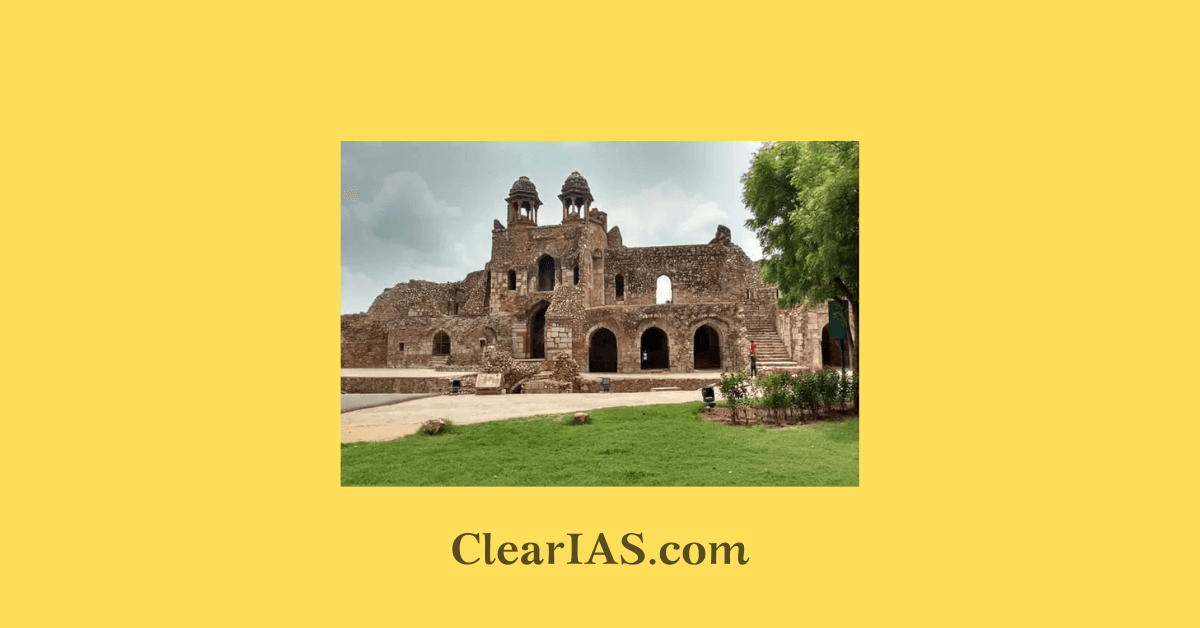
In Delhi’s Purana Qila (Old Fort), new excavations by the Archaeological Survey of India (ASI) have uncovered a continuous history spanning more than 2,500 years. The goal of these excavations is to determine the site’s whole chronology. Read here to learn more.
The greatest mysteries are hidden beneath the Purana Qila complex, and Delhi’s past is older than what the layers of dirt have so far disclosed.
The purpose of this cycle of archaeological excavation at the location is to descend to the historical period known as the “Mahabharat period,” which is thought to have begun around 900 BCE.
It was the late Padma Vibhushan-winning archaeologist B.B. Lal who first linked the site to the Mahabharat period, during the pioneering and elaborate excavation work he conducted inside Purana Qila grounds in 1954 and then from 1969-73.
The last two archaeological excavations, in 2013-14 and 2017-18, found cultural deposits from Maurya to Shunga, Kushana, Gupta, Rajput, Sultanate, and Mughal periods.
The Cities of Delhi
- The Lal Kot, a fortification wall built by Tomar Rajputs and renamed Qila Rai Pithora by Prithviraj Chauhan in the 12th century, is believed to be one of the oldest standing structures in Delhi.
- Prithviraj is said to have lost it, soon after, to the invading forces of Muhammad of Ghor in 1192 CE.
- The Ghurid commander Aibek, who was left in charge of the dominions in Hindustan, developed the existing fort and built the Quwwat-ul-Islam Mosque and the Qutb Minar within its premises.
- This site is traditionally known as the first city of Delhi.
- Subsequently, along with the coming of other dynasties to power, more cities came up- Siri, Tughlaqabad, Jahanpanah, Firozabad, Dinpanah, and Shahjahanabad.
Purana Qila Complex
The Purana Qila is a timeless monument that stands on the South Eastern part of the present city of New Delhi.
The Mughal Emperor Humayun built the Purana Qila as a part of his new city of Dinpanah in the 16th century.
- Humayun started building the Purana Qila in 1533 CE as a part of his new fortified city named Din Panah or the “Sanctuary of Faith”.
- A local tradition believes that the area in which the Purana Qila stands today is the site of Indraprastha, the capital of the Pandavas of the great epic Mahabharata.
- It is for the same reason that the Purana Qila is often called the “Pandavon ka Qila”.
Excavations at this site in 1954–55 and 1969 -1973, conducted by the Archaeological Survey of India and headed by BB Lal, revealed a few shards of pottery belonging to the Painted Grey Ware (PGW) variety, that historians trace to the Mahabharata period (1500-1000 BCE).
- They also revealed the existence of stratified layers belonging to 8 periods starting from the 4th century CE and continuing right up to the 19th century, confirming that the site had a long and unbroken chain of habitation for centuries.
- Apart from archaeology, textual sources such as the Ain-i-Akbari of Abul Fazal (16th century), mention that Humayun had built the fort at the site of Indraprastha-the ancient capital of the Pandavas.
- In fact, till 1913, there was in existence a village named Inderpat within the fort walls.
- The village was relocated after the British started building the modern capital of Delhi.
Sher Shah Suri took over the Qila in 1540 CE. The Suri reign of 15 years was significant in terms of the architectural development of the fort. Sher Shah renamed Din Panah Sher Garh and built various important structures within it.
After Humayun’s death, Akbar continued to rule from Din Panah until 1571 CE when he founded the new Mughal capital of Fatehpur Sikri in Agra.
Delhi’s imperial significance then declined for some time until the reign of Emperor Shah Jahan.
Shah Jahan, however, opted to build his new capital city of Shahjahanabad (1639 CE) instead of reviving Din Panah.
The architecture of Purana Qila Complex
The Purana Qila fort complex is a conglomerate of various structures that lie scattered over an area of more than 300 acres.
- It was surrounded by a wide moat that was linked to the river Yamuna- the waters of which once lapped against the eastern walls of the fort.
- It is believed that only a few monuments have survived out of the original structure.
- Some of these standing structures are believed to be Humayun’s work while others are attributed to Sher Shah.
The grandeur of the Purana Qila can be surmised from the three majestic gateways that stand today.
- The Bada Darwaza acts as the main and only point of entry to the fort today. It is a robust structure flanked by two massive bastions. While the gate is made of red sandstone with inlays of white and greyish-black marble, the bastions are constructed of stone and rubble. Multiple slits for arrows are visible both in the upper part of the gate and the bastions. The
- Humayun Darwaza is the southern entry to the fort complex. This gateway is divided into two stories with a high arch in the middle.
- The third gateway, the Talaqi Darwaza, or the Forbidden Gate, is located on the northern side of the complex. The name Talaqi is an intriguing one and has several interesting stories attached to it. The gateway has two entrances- upper and lower. While the upper and more ornamental one served as the main entrance, the lower one once opened at the level of the moat.
A prominent structure of the Purana Qila is the Qila-e-Kuhna mosque built by Sher Shah in 1542 CE. This mosque is an aesthetic structure that reflects a transitional stage between the architecture of the Lodhis and the Mughals.
- The architectural features encountered here appear in more pronounced forms in the monuments built by Emperor Akbar later on.
- The Qila-e-Kuhna is a rectangular domed structure built in grey quartzite with profuse use of red and yellow sandstone. The façade of the structure contains five arches.
- The central one or the Iwan is beautifully embellished with bands of calligraphy of verses from the Quran inscribed on it.
- The architectural and symbolic focal point of the mosque is the Mihrabs that face west and indicate the direction of prayer.
- The ceiling of the central dome represents a fine example of the brilliant craftsmanship involved in covering a rectangular space with a circular dome.
- The four corners are filled by what is known as squinches that are exquisitely carved.
- Throughout the mosque, one can witness a harmonious blend- of Islamic architecture, that originated in West and Central Asia, and indigenous Hindu stylistic motifs such as the Kalash and the lotus.
Another prominent structure inside the Purana Qila is the Sher Mandal. This structure is believed to have been built by Sher Shah in around 1541 CE.
- After Humayun recaptured the throne, he is said to have converted this building into a library.
- The Sher Mandal is a compact octagonal structure built in red sandstone and sparingly decorated with white and black marble inlay.
- Emperor Humayun had a fatal fall on the steps of this very structure.
Close to the Sher Mandal lies a baoli or a stepwell. The baoli consists of a long flight of stairs, interrupted by landings, that lead to the water level. This structure is an interesting example of how water supply was managed during medieval times.
Another structure is the hammam or the bathhouse. Flights of narrow and steep steps lead to this closed underground chamber wherein one can still see the terracotta pipes and chutes that enabled the water supply.
Two other outlying structures that are often perceived as part of the Purana Qila are the Lal Darwaza and the Khairul Manazil.
- The Lal Darwaza or the Red Gate is an imposing gateway built of red sandstone and grey quartzite believed to be the southern entrance to the city of Sher Garh.
- The Khairul Manazil was commissioned by Maham Anga, Akbar’s wet nurse, around 1561-62 CE to house a mosque and a madrassa.
- The structure though fairly simple still speaks of the power and influence that Maham Anga held in Akbar’s life.
Sir Edwin Lutyenswho built the modern imperial capital of Delhi (1912-1930) for the British, is said to have aligned the central vista, now called the Rajpath, with the Humayun Darwaza of the Purana Qila.
During the Second World War, the premises of the fort also served as an internment camp for Japanese civilians in British India.
During the Partition of India in 1947, hundreds of refugees are said to have camped at the Purana Qila for several months.
Findings of recent excavations
Nine cultural stages, including Pre-Mauryan, Mauryan, Sunga, Kushana, Gupta, Post-Gupta, Rajput, Sultanate, and Mughal, have been revealed through artifacts from various historical eras.
- Shards of Painted Gray Ware Pottery: These pottery pieces are typically dated to the period of 1200 BC to 600 BC, indicating the existence of human settlements in the pre-Mauryan era.
- Vaikuntha Vishnu Sculpture: A 900-year-old sculpture of Vaikuntha Vishnu, belonging to the Rajput period, was discovered during the excavation.
- Terracotta Plaque: A terracotta plaque depicting the goddess Gaja Lakshmi, dating back to the Gupta period, was found at the site.
- Terracotta Ring Well: The remains of a well dating back 2,500 years from the Mauryan period were unearthed.
- Sunga-Kushan Period Complex: The excavation revealed a well-defined four-room complex from the Sunga-Kushan period, which dates back approximately 2,300 years.
- Coins, Seals, and Copper Artifacts: More than 136 coins, 35 seals and sealings, and other copper artifacts were discovered at the site. These findings indicate the site’s significance as a center for trade activities.
-Article written by Swathi Satish
#Purana #Qila #Complex #Grand #Fort #Delhi
Source link

